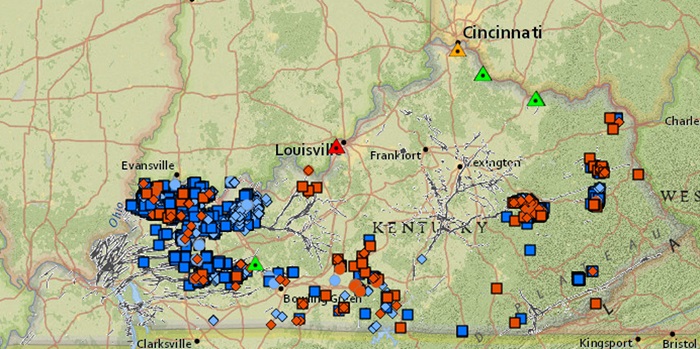

KGS Home > News and Announcements
Final Report Issued for Brine Disposal Framework for the Northern Appalachian Basin
Increasing shale-gas production and the accompanying production of brine and flowback waters from wells have increased demands for disposal wells in the Appalachian Basin. In response, a multistate project began three years ago to develop a geologic and operational framework for safe and economical disposal of the produced fluids in the northern Appalachian Basin. The project was funded by the Research Partnership to Secure Energy for America; Battelle Memorial Institute was the principal investigator. State surveys in Ohio, Pennsylvania, West Virginia, and Kentucky were subcontractors on the project. Kentucky Geological Survey staff, Tom Sparks and Marty Parris, conducted the Kentucky portion of the work.
The project study area covered eastern Kentucky, Ohio, Pennsylvania, and West Virginia. Operational data for more than 200 Class II brine-disposal wells were collected from 2008 through 2012. The compilation showed brine has been injected into a variety of Cambrian through Pennsylvanian reservoirs, and injection in these reservoirs increased from 6 to 7 million barrels per year to about 18 million barrels per year by 2012. The more than twofold increase was driven largely by shale-gas development. In addition, the study compiled reservoir data, developed models for reservoir characteristics, and conducted advanced reservoir and geomechanical simulations.
KGS contributed three whole-core samples for rock mechanics (compressive, acoustic, and tensile-strength testing) from the KGS No. 1 Hansen Aggregates stratigraphic test well in Carter County. Operational data (monthly volumes injected, average and maximum injection pressures) were provided for 30 active brine-injection wells in eastern Kentucky.
The project ended last October, and a final report is available at the Research Partnership website, www.rpsea.org/projects/11122-73. One of the major findings of the study was provided through a source-sink analysis, a geographic analysis of where produced fluids are generated and where they can be disposed of. The analysis concluded that "there may be ultimate demand for brine disposal related to unconventional production of approximately 700-2,300 million barrels, while the capacity for brine disposal in depleted oil and gas zones and deep saline rock formations may be nearly 500 billion barrels."

The brine-disposal project’s final report references the KGS online map service that provides locations and detailed information on all disposal wells in Kentucky.
Tom Sparks developed the map service, which can be found at http://goo.gl/dLrmqE .